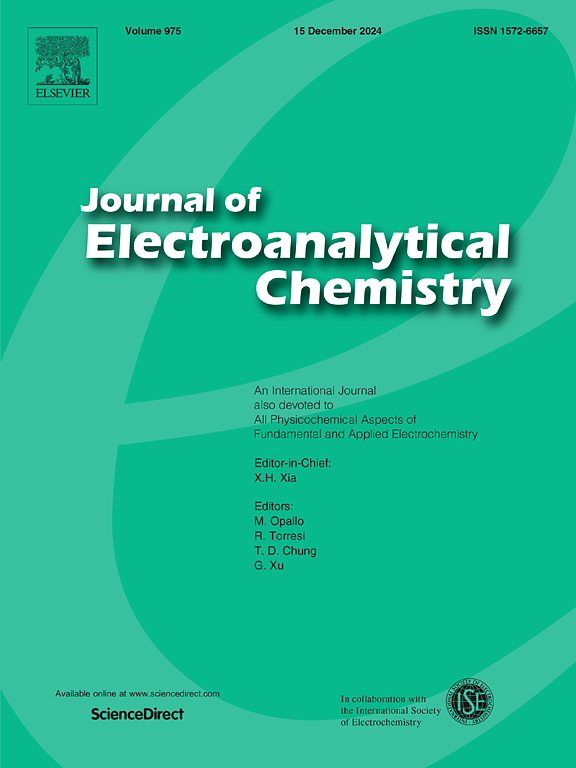Crystallinity-controlled oxygen vacancies of SmMn2O5 as an oxygen reduction catalyst for Zn-air battery
IF 4.1
3区 化学
Q1 CHEMISTRY, ANALYTICAL
引用次数: 0
Abstract
Mn-based mullite, with its unique structure featuring two distinct Mn coordination environments, has garnered significant attention in the research and development of oxygen reduction reaction (ORR) catalysts. The nucleation and growth of SmMn2O5 were influenced by controlling the hydrothermal reaction time and temperature, resulting in SmMn2O5 with varying degrees of crystallinity. With the increase of hydrothermal temperature and time, the crystallinity of SmMn2O5 is enhanced, and the morphology changes from an amorphous lamellar structure to a finer and longer nanorod structure. SmMn2O5 with an amorphous lamellar structure prepared at 150 °C for 3 h has a maximum specific surface area of 355.35 m2 g−1. The electrochemical results indicate that the amorphous lamellar SmMn2O5 shows excellent ORR performance with a half-wave potential of 0.76 V. This is mainly due to the fact that crystallinity induces an increase in the number of oxygen vacancies, which increases the number of active sites and changes the valence state of Mn. The amorphous lamellar SmMn2O5 was used as a cathode in zinc-air batteries with a power density of 119 mW/cm2, showing potential applications. This work demonstrates an effective and simple strategy for increasing the number of oxygen vacancies in SmMn2O5, which helps the development and application of SmMn2O5 in the field of electrocatalysis.

SmMn2O5作为锌-空气电池氧还原催化剂的结晶控制氧空位
锰基莫来石具有独特的结构,具有两种不同的锰配位环境,在氧还原反应(ORR)催化剂的研究和开发中备受关注。通过控制水热反应时间和温度可影响 SmMn2O5 的成核和生长,从而得到不同结晶度的 SmMn2O5。随着水热反应温度和时间的增加,SmMn2O5 的结晶度提高,形态由无定形的片状结构转变为更细更长的纳米棒结构。在 150 °C 下经过 3 小时制备的非晶片状结构 SmMn2O5 的最大比表面积为 355.35 m2 g-1。电化学结果表明,非晶片状 SmMn2O5 具有优异的 ORR 性能,半波电位为 0.76 V。无定形片状 SmMn2O5 被用作锌-空气电池的阴极,功率密度达到 119 mW/cm2,显示了其潜在的应用价值。这项工作展示了增加 SmMn2O5 中氧空位数量的一种有效而简单的策略,有助于 SmMn2O5 在电催化领域的开发和应用。
本文章由计算机程序翻译,如有差异,请以英文原文为准。
求助全文
约1分钟内获得全文
求助全文
来源期刊
CiteScore
7.80
自引率
6.70%
发文量
912
审稿时长
2.4 months
期刊介绍:
The Journal of Electroanalytical Chemistry is the foremost international journal devoted to the interdisciplinary subject of electrochemistry in all its aspects, theoretical as well as applied.
Electrochemistry is a wide ranging area that is in a state of continuous evolution. Rather than compiling a long list of topics covered by the Journal, the editors would like to draw particular attention to the key issues of novelty, topicality and quality. Papers should present new and interesting electrochemical science in a way that is accessible to the reader. The presentation and discussion should be at a level that is consistent with the international status of the Journal. Reports describing the application of well-established techniques to problems that are essentially technical will not be accepted. Similarly, papers that report observations but fail to provide adequate interpretation will be rejected by the Editors. Papers dealing with technical electrochemistry should be submitted to other specialist journals unless the authors can show that their work provides substantially new insights into electrochemical processes.

 求助内容:
求助内容: 应助结果提醒方式:
应助结果提醒方式:


